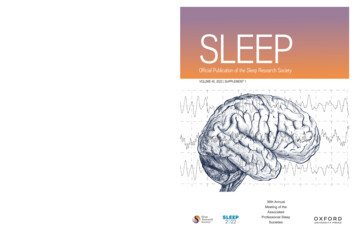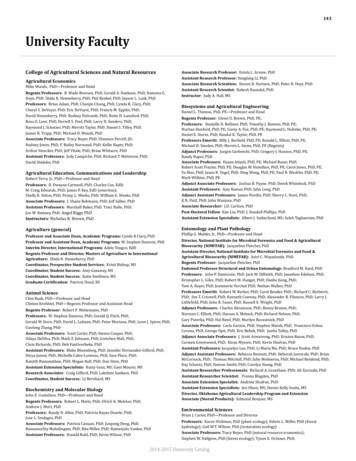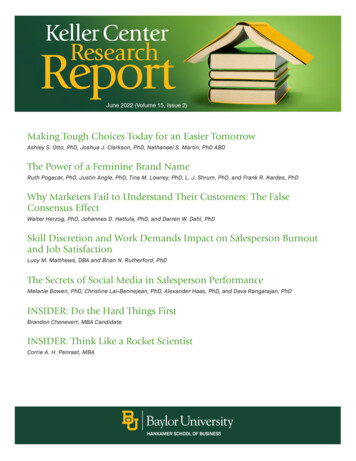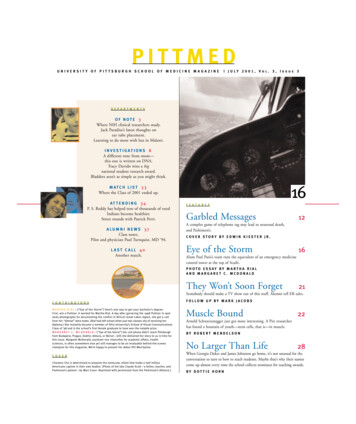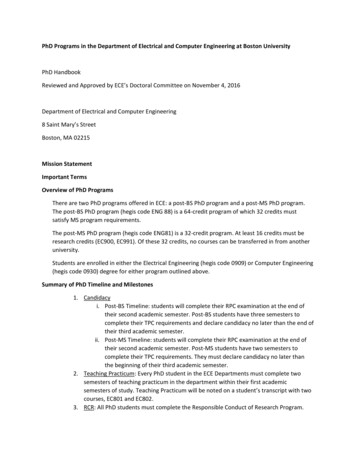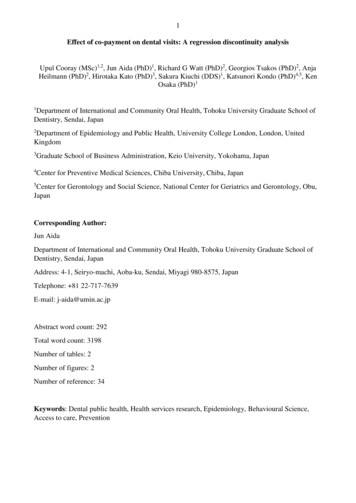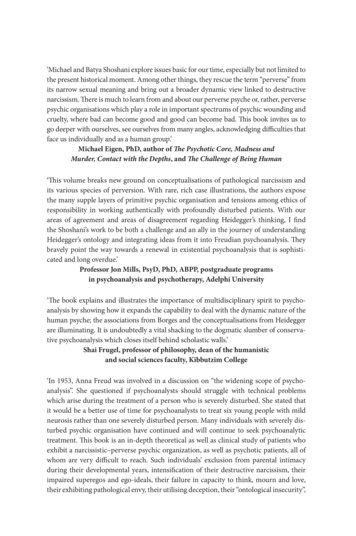
Transcription
‘Michael and Batya Shoshani explore issues basic for our time, especially but not limited tothe present historical moment. Among other things, they rescue the term “perverse” fromits narrow sexual meaning and bring out a broader dynamic view linked to destructivenarcissism. There is much to learn from and about our perverse psyche or, rather, perversepsychic organisations which play a role in important spectrums of psychic wounding andcruelty, where bad can become good and good can become bad. This book invites us togo deeper with ourselves, see ourselves from many angles, acknowledging difficulties thatface us individually and as a human group.’Michael Eigen, PhD, author of The Psychotic Core, Madness andMurder, Contact with the Depths, and The Challenge of Being Human‘This volume breaks new ground on conceptualisations of pathological narcissism andits various species of perversion. With rare, rich case illustrations, the authors exposethe many supple layers of primitive psychic organisation and tensions among ethics ofresponsibility in working authentically with profoundly disturbed patients. With ourareas of agreement and areas of disagreement regarding Heidegger’s thinking, I findthe Shoshani’s work to be both a challenge and an ally in the journey of understandingHeidegger’s ontology and integrating ideas from it into Freudian psychoanalysis. Theybravely point the way towards a renewal in existential psychoanalysis that is sophisticated and long overdue.’Professor Jon Mills, PsyD, PhD, ABPP, postgraduate programsin psychoanalysis and psychotherapy, Adelphi University‘The book explains and illustrates the importance of multidisciplinary spirit to psychoanalysis by showing how it expands the capability to deal with the dynamic nature of thehuman psyche; the associations from Borges and the conceptualisations from Heideggerare illuminating. It is undoubtedly a vital shacking to the dogmatic slumber of conservative psychoanalysis which closes itself behind scholastic walls.’Shai Frugel, professor of philosophy, dean of the humanisticand social sciences faculty, Kibbutzim College‘In 1953, Anna Freud was involved in a discussion on “the widening scope of psychoanalysis”. She questioned if psychoanalysts should struggle with technical problemswhich arise during the treatment of a person who is severely disturbed. She stated thatit would be a better use of time for psychoanalysts to treat six young people with mildneurosis rather than one severely disturbed person. Many individuals with severely disturbed psychic organisation have continued and will continue to seek psychoanalytictreatment. This book is an in-depth theoretical as well as clinical study of patients whoexhibit a narcissistic–perverse psychic organization, as well as psychotic patients, all ofwhom are very difficult to reach. Such individuals’ exclusion from parental intimacyduring their developmental years, intensification of their destructive narcissism, theirimpaired superegos and ego-ideals, their failure in capacity to think, mourn and love,their exhibiting pathological envy, their utilising deception, their “ontological insecurity”,
their other common experiences and characteristics and therapeutic responses to themare brilliantly examined and illustrated with clinical examples. The book ends illustrating how perverse narcissistic processes represented in films, literature and philosophicalthoughts, expand our theory and praxis. I consider this volume a valuable textbook thatpsychoanalysts and psychotherapists should keep on their bookshelves.’Vamık D. Volkan, professor emeritus of psychiatry, president emeritus ofInternational Dialogue Initiative, and author of Large-Group Psychology‘This book by Batya and Michael Shoshani is a brilliant example of lucid and originalfour-handed writing which, all throughout the book, demonstrates various manifestations of the ‘third party’ in the analytic situation: from a spouse’s insight to the involvement of diverse fields of knowledge. The proposed psychoanalytic conceptualisation ofthe perverse-psychotic spectrum draws on literature and philosophy, but not throughthe conventional and familiar interdisciplinary conjunction. The appeal to these texts isnot scholarly or disciplinary in the narrow sense of the word. Rather, its motivation isan existential one: these texts, therefore, are gradually revealed as constituting the verypossibility of analytic reverie.’Dr Michal Ben-Naftali, writer, philosopher, translator, and lecturer‘Michael and Batya Shoshani have produced an important and timely book on the complex interrelationship between narcissism and perversion. The two authors use immensescholarship to bring together psychoanalysis, literature, and philosophy in a psychoanalytic/existential synthesis exploring the conceptual and clinical underpinnings of perverse phenomena. I especially enjoyed their close reading and informative comparisonof the work of Freud and Heidegger. In addition, their clinical case examples are vivid,moving, and informative. I wholeheartedly recommend this book as an invaluable addition to the psychoanalytic literature.’Dr Peter Shabad, psychoanalyst, writer, and professorin Northwestern’s Feinberg School of Medicine‘It is often at the interface of different fields of inquiry that new ideas emerge. In thisfascinating and lucid volume, Michael and Batya Shoshani have successfully exploredthe nexus of psychoanalysis, literature, film, and philosophy to discover new ways tounderstand and relate to psychoanalytic patients. They boldly take on problematic psychopathologies such as perversions and narcissism, bringing to light creative means totreat them by having in mind the wisdom of literary figures such as Jorge Luis Borgesand philosophers like Martin Heidegger. This intellectual and clinical tour de force istruly a gift for psychoanalytic practitioners and theoreticians alike.’Stanley B. Messer, PhD, distinguished professor emeritus and former dean,Graduate School of Applied and Professional Psychology, Rutgers University
TIMELESS GRANDIOSITY ANDEROTICISED CONTEMPTTechnical ChallengesPosed by Narcissismand PerversionMichael ShoshaniandBatya Shoshani
First published in 2021 byPhoenix Publishing House Ltd62 Bucknell RoadBicesterOxfordshire OX26 2DSCopyright 2021 by Michael Shoshani and Batya ShoshaniThe rights of Michael Shoshani and Batya Shoshani to be identified as the authors of thiswork have been asserted in accordance with §§ 77 and 78 of the Copyright Design andPatents Act 1988.All rights reserved. No part of this publication may be reproduced, stored in aretrieval system, or transmitted, in any form or by any means, electronic, mechanical,photocopying, recording, or otherwise, without the prior written permission of thepublisher.British Library Cataloguing in Publication DataA C.I.P. for this book is available from the British LibraryISBN-13: 978-1-912691-61-6Typeset by Medlar Publishing Solutions Pvt Ltd, Indiawww.firingthemind.com
To the memory of Steve MitchellA mentor and a friend who wouldhave revolutionised psychoanalysis—Michael ShoshaniTo the memory of HediMy one-of-a-kind sister—Batya Shoshani
A strong egoism is a protection against falling ill. But in the last resort we mustbegin to love in order not to fall ill, and we are bound to fall ill if, in consequence of frustration, we are unable to love.—Freud, “On Narcissism” (1914c, p. 85)
ContentsForeword by Salman AkhtarAcknowledgementsPermissionsAbout the authorsIntroduction: perversion and narcissismxixvxviixixxxiPart INarcissistic–perverse constellations—clinical material and conceptualisationsCHAPTER ONEPsychic survival versus psychic freedom:reflections on Symington’s theory of narcissismCHAPTER TWOOn mother–son twisted coalition:a precursor of perverse psychic organisationCHAPTER THREEGreen eyes, crows, and scorpions: envy in the contextsof neediness, separateness, and narcissismBatya Shoshani, Michael Shoshani, and Rachel Kellaix32351
xCONTENTSCHAPTER FOURDo I dare to be human? The perverse failureto mourn, to think, and to love77CHAPTER FIVEFear and shame in an Israeli psychoanalystand his patient: lessons learned in times of war95CHAPTER SIXThe impact of perverse character pathology on the transference–countertransference matrix of patient, therapist, and supervisor125Part IIInterdisciplinary dialoguesCHAPTER SEVENBitter MoonCHAPTER EIGHTWhen one plus one equals one: truth and blindnessin the oedipal myth and the film IncendiesBatya Shoshani, Gila Ofer, and Michael ShoshaniCHAPTER NINEBorges in my office: the analysis of a man dwellingoutside of timeCHAPTER TENHeidegger and Freud—explorations into truth,anxiety, and deathMichael Shoshani, Naama Shoshani-Breda, and Batya ShoshaniNotesReferencesIndex149169189219257273291
ForewordSalman AkhtarLet us begin by imagining the following scenarios: An elderly woman takes care of her orphaned grandson.A young man dies in the process of donating a kidney to his sister.A couple is engaged in passionate lovemaking.A father is playing basketball with his son on the driveway of theirhouse. A young mother shyly offers her breast to her newborn baby.And now, consider Sartre’s cynical aphorism that “Hell is other people”.Of course, an immediate objection to such juxtaposition would be thatthe philosopher was not talking about the pragmatic benefits one drawsfrom others but of the fact that separateness, unfamiliarity, and difference can evoke the “hell” of anxiety, pain, shame, and anger. This is true.However, life without the novelty and freshness that other minds bringto us is no “heaven” either. Thought, creativity, and imagination of others invariably enrich our minds. While encounters with great works ofthe arts, science, literature, and music give testimony to this, ordinaryconversations with friends and family also replenish our inner worlds.xi
xiiFOREWORDThese human connections are also the main consolation vis-à-vis ourexistential plight of our going towards death. In fact, without an activeinvolvement with others, our lives become hollow, aimless, and condemned to the prison of narcissism. Object relatedness then gives wayto auto-eroticism, humility is cast aside in favour of regressive omnipotence, and the lambent joy of mutuality is replaced by the brutal certainty of perversion.It is at this point in life’s theatre that Michael and Batya Shoshani’sbook enters the stage. Written in a theoretically grounded yet highlyengaging style, their book seeks to broaden and deepen our understanding of pathological narcissism and its intricate links with the arrogantdefiance of oedipal realities and with perversions. The authors are wellaware of the tension that exists between the “classic” and contemporary,especially postmodern and social constructivist, viewpoints in this realm.They open their book by elucidating the range of opinions that stretchfrom the categorical edicts of Freud’s Three Essays, through Stoller’s proposal that eroticisation of hatred forms the basis of all perversions, toDimen’s warning that nosological distinctions along such lines restrictopen-ended thinking and tend to take on judgemental overtones. TheShoshanis locate themselves at the midpoint of this continuum, respecting cultural trends but also mindful of clinical realities. Moreover, theyfind sexual aberration as but one pathway of the “perverse-psychotic”constellation centred upon destructive narcissism, mindlessness, envy,reality distortion, and overthrow of the tragic dimensions of the oedipaluniverse.Deploying a dual track of evidence gathering, the Shoshanis dividetheir book into two parts. The first resolutely focuses upon the clinicalsituation. The second freely roams over the terrain of myth, literature,poetry, cinema, and philosophy. Chapters contained in the first sectioninclude the authors’ engagement with Symington’s perspective on narcissism, elucidation of the analytic process with a narcissistic and embittered man who was maternally seduced as a child (hence, betrayed as anadult), technical handling of malignant envy, hatred of thinking, incapacity to bear separateness and mourn the loss of perfection, denial oflimitations, and legitimate fear. This section also addresses the spillageof perverse sexualisation in the crucible of transference and countertransference as well as in the triangulated space between the patient,
FOREWORDxiiitherapist, and his or her supervisor. In this context, the authors stress thevital need of meeting the therapist’s own perverse and psychotic parts.The authors’ discourse is replete with lively and convincing clinicalmaterial and displays their earnest effort at helping patients advancefrom solipsism to mutuality, from thoughtless certainty to tolerance ofambiguity, and from the language of perversion to the language of love.Although the omission of Sharpe’s important paper (1940) on libidinisation of speech is noticeable, one is nonetheless impressed by the authors’literature coverage which includes writings as wide-ranging as those ofFreud, Klein, and Winnicott, through Bion, Green, and ChasseguetSmirgel to Ogden, Britton, Loewald, Meltzer, and Bach.The second part of the book approaches the issues raised in its clinical section by demonstrating their ubiquity in human imagination andcreativity. The authors go on to show how immersing themselves inseveral distinct works of art had helped them to understand those veryhard-to-reach patients and empathise with them. The dark pleasure ofsubjugation and sadomasochism are experienced via the writings of theMarquis de Sade and movies such as Polanski’s Bitter Moon (one of myfavourites, by the way) and Villeneuve’s Incendies. The authors’ discourse, while focused upon the literary and cinematic material at hand,never loses sight of their clinical counterpart on the one hand and theirmetapsychological foundation in the eternal war between life and deathinstincts on the other hand. The same spirit pervades their subsequentpresentation and use of certain stories by Borges and their thoughtprovoking juxtaposition of Freud and Heidegger. This last essay tacklesthese two thinkers’ perspectives on truth, anxiety, and death—all threebeing pertinent to the authors’ main concern: narcissism, escape fromreality, and undue sexualisation and aggressivisation of life. The authorsthus open a window to the possibility of adding Heidegger’s existentialontological dimension to the psychoanalytic paradigm.All in all, this book by the Israeli husband-and-wife duo, Michael andBatya Shoshani, is a powerful testimony to how ontogenetic mishapsand misfortunes can trap human beings into the stifling, if mesmerising,jailhouse of false self-sufficiency. Fortunately, and to the authors’ credit,the book also lays bare how the provision of psychoanalytic insightscoupled with compassion, forbearance, and sustained empathy can meltthe iron bars of this prison.
AcknowledgementsWe are grateful to Professor Salman Akhtar MD: without his encouragement, generosity, and inspiration this book would not have beenpublished.Our sincere gratitude to all of our analysts, teachers and supervisors,colleagues, students—and especially our patients, who enriched ourthinking and helped us crystallise our thoughts, leading to the writingof the book. Their names are too many, but we would like to express ourspecial gratitude to a few:Tirza Zandbank, Bat Sheva Adler, Rina Moses, Samuel Erlich, RaananKulka, Nevil Symington, Malka Hirsch-Napchan, Sheldon Bach, LouAron, Stephen A. Mitchell, Thomas Ogden, Shay Frugel, Tessa Zadok,Rakefet Efrat Lebkovitv, Yuval Adler.The founding members, analysands, supervisees, and students of theTel Aviv Institute of Contemporary Psychoanalysis (TAICP).Amir Atzmon, Dan Gilon, Tova Shani, Yael Maor, Michal Budnik,and Kate Astrom for assisting in the writing, translation, and editingprocess.Rachel Kela and Mitchell Baker who were active partners in thethinking and writing of the paper on which Chapter Three is based.xv
xviACKNOWLEDGEMENTSGila Ofer, our dear friend and partner in founding the TAICP, andwho initiated the paper on which Chapter Eight is based, and was anactive participant in its writing.To our daughters—Naama, who, based on her philosophical training, facilitated and introduced us to Heidegger’s thinking, followed byher full participation in the writing of Chapter Ten; and to Yael, who asa clinician read a few of the chapters and helped us to consolidate andsharpen our thinking and understanding.Last, to Phoenix Publishing House and its principal Kate Pearce whoaccompanied us generously through this journey.
PermissionsChapter One is based on “Psychic Survival versus Psychic Freedom: Reflectionson Symington’s Theory of Narcissism” published in Progress in Self Psychology, 2013, 19: 133–151. Reprinted by permission of Taylor & Francis Group,LLC Books.Chapter Two is based on “On Twisted Coalitions and Perverse-NarcissisticConfigurations: From Positivistic Oedipal Third to an Existential Relational Third: A Case Study” published in Psychoanalytic Psychology, 2009,26(2): 134–157. Reprinted by permission of the American PsychologicalAssociation.Chapter Three is based on “Green Eyes, Crows and Scorpions: Envy in theContexts of Neediness, Separateness, and Narcissism” published by Psychoanalytic Psychology, 2012, 29(4): 440–458. Reprinted by permission of theAmerican Psychological Association.Chapter Four is based on “Do I Dare to Be Human? The Perverse Failure toMourn, to Think, and to Love” published by Psychoanalytic Review, 2016,103(3): 371–395. Reprinted by permission of the National PsychologicalAssociation for Psychoanalysis and Guilford Publications.Chapter Five is based on “Fear and Shame in an Israeli Psychoanalyst and HisPatient: Lessons Learned in Times of War” published in Psychoanalyticxvii
xviiiPERMISSIONSDialogues, 2010, 20(3): 285–307. Reprinted by permission of Taylor & Francis Group, LLC Books.Chapter Nine is based on “Borges in My Office: The Analysis of a Man Dwelling Outside of Time” published in Psychoanalytic Quarterly, 2013, 82(3):635–669. Reprinted by permission of Taylor & Francis Group, LLC Books.EpigraphsEpigraphs taken from the following are reproduced with permission.Eliot, T. S. (1936). “Burnt Norton”. Reproduced by permission of Faber & Faber.Green, A. (2001). Life Narcissism, Death Narcissism. London: Free Association.Reproduced by permission of the publisher.Levin, H. (1999). Those who walk in darkness. In: Those Who Walk in Darknessand Other Plays (pp. 7–70). Tel Aviv, Israel: Am Oved. [In Hebrew.] Reproduced by permission of the estate of Hanoch Levin.Meltzer, D., & Williams, M. H. (1988). The Apprehension of Beauty: The Role ofAesthetic Conflict in Development, Art, and Violence. Karnac, 2008. Reproduced by permission of the Harris Meltzer Trust.The authors and publisher made every effort to trace the rights holderfor the works of Borges to no avail. The quotations are all attributedappropriately.
About the authorsBatya Shoshani, PhD, a Fullbright scholar, is a training and supervising psychoanalyst and a professor of clinical social work at the HebrewUniversity of Jerusalem (retired), with vast experience in teaching andsupervision in social work, psychotherapy, and psychoanalysis. She is afounding member and the past chair of the training committee at TheTel Aviv Institute for Contemporary Psychoanalysis. She has been asenior consultant for public services dealing with children, adolescents,battered women, and delinquent youth. She is interested in interdisciplinary studies in psychoanalysis, weaving clinical knowledge with philosophy, literature, and art. In addition, Batya has shown great interestin the particular theory and technique of perversions alongside MichaelShoshani, PsyD, and has written numerous articles regarding thesesubjects. Batya is living and practising in Tel Aviv, Israel.Michael Shoshani, PsyD, MBA, a Fullbright scholar, is a senior clinical psychologist and a training and supervising psychoanalyst. He isthe founding chair and a faculty member of The Tel Aviv Institute ofContemporary Psychoanalysis. He is a faculty member and supervisorat the New York University Postdoc Program for Psychoanalysis andxix
xxABOUT THE AUTHORSPsychotherapy, and an active member of the American PsychoanalyticAssociation (APsaA) and the International Psychoanalytical Association(IPA). For three decades, he has treated patients, taught students, andsupervised clinicians. He has lectured for many years at Tel Aviv University and Bar Illan University, in the postgraduate programs of psychoanalytic psychotherapy, and has run workshops for many groups ofprofessionals in Israel, the USA, Turkey, and Romania. His main interestis the clinical theories relating to the therapy and analysis of narcissisticand perverse character pathology, as well as in interdisciplinary studiesin psychoanalysis, weaving clinical knowledge with philosophy, literature, and art. He is the author of the book Dare to be Human: A Psychoanalytic Journey and has published numerous articles on these subjects.Michael is living and practising in Tel Aviv, Israel.
IN TR O D U CT I O NPerversion and narcissismPsycho-analysis stands firm on its philosophical foundations of beliefin individuality, of the primacy of psychic reality, and therefore ofthe concreteness of responsibility. It is bound to view all statisticalconcepts of normality [ ] as hypocritical or even cynical evasionsof responsibility when they are put forward as causal explanation ofhuman behavior. It must be equally suspicious of cosmic mysticism.But it has a mysticism of its own, as does all science which has notarrogantly left the rails, namely that the plumbing of the mysteriesof the universe never intends to answer the ultimate question anddestroy our awe and wonder.—Meltzer, 1973The difficulties and crises that kept resurfacing in our work with patientswith perverse psychic organisation motivated us to write this book. Ourproject is an attempt to propose a clinical conceptualisation that wouldenhance our understanding of these lost and confused patients, whosenarcissistic struggle against human fate defies reality and truth, challenging the analyst and the analytic situation.xxi
xxiiINTRODUCTIONThese patients are extremely difficult to reach, often causing considerable turmoil and confusion in the consulting room, particularly inregard to countertransference. The analyst finds themself caught betweentheir own perception of reality and truth, and the wish to be empatheticto their patient’s experience and view of reality, often feeling torn andas if standing on quicksand. These patients are proof that our trustedanalytic toolkit often lets us down. They confront the analyst with a challenge that sometimes becomes a real threat, undermining their capacityto think (Steiner, 2006). We hope that the clinical material and the conceptual formulations we propose might enrich the ongoing professionaldialogue on these perplexing and illusive psychic phenomena.1Perversion: the term and the controversyAs a term, perversion is quite controversial. Throughout history, itsconnotations in psychoanalysis and in other contexts, have been quitevolatile. Proponents of “cultural relativity” have pointed out that different times create different realities, claiming that the term “perversion”has often been used politically, as an instrument for condemning andexcluding certain individuals. Analysts who support this approach, suchas Muriel Dimen (2012), have criticised the use of this term in psychoanalysis, warning that it may prove dangerous. They claim, with a fairamount of merit, that using the term to set apart various categories ofpeople perpetuates judgemental, moralistic, and exclusionary differentiations, and tips the scales towards the restrictive and regulatoryaspects of psychoanalysis. Indeed, Freud himself objected to such use,stating thatNo healthy person, it appears, can fail to make some additionthat might be called perverse to the normal sexual aim; and theuniversality of this finding is in itself enough to show how inappropriate it is to use the word perversion as a term of reproach.(Freud, 1905d, p. 160)In contrast, other analysts, such as Stoller (1974), insist that psychoanalysis should learn to stand fast by its beliefs about human nature and
INTRODUCTIONxxiiiits commitment to the suffering individual. They warn against throwing the baby out with the bathwater by rushing to get rid of conceptsand understandings that no longer coincide with the cultural zeitgeist.Theoretical changes must remain the result of theoretical or clinical developments rather than the consequences of political pressure.This perspective sees the current atmosphere of political correctness ascurtailing the scientific liberty to think and express valid arguments.Regarding this debate, we are of two minds. While we believe thatpsychoanalytic theory should remain connected to contemporary socialand cultural theory and reality, we are also confident that certain intrinsic truths regarding specific unique psychic phenomena should be studied in an unbiased analytic environment. We are indeed keenly awareof the problematic nature of the term “perversion” and acknowledgewith understanding the various objections to its use. We hope that amore appropriate less derogatory term would be found to describethese unique and illusive pathological entities as our understanding ofthem deepens. Still, while analytic thinkers continue debating the useof the term “perversion”, suffering patients cross our doorstep every dayand we are often helplessly struggling to address their predicament. Inorder to help them, we need a concept to capture and illuminate certainpsychic nuances that are overlooked by other overlapping conceptualisations of pathology (Filippini, 2005). In agreement with ChasseguetSmirgel and Stein, we believe that perversions are distinct nosologicalentities (Chasseguet-Smirgel, 1986; Stein, 2005). However, it appears tous that the individual perverse psychic organisation may be located on aperverse-psychotic continuum.The question of whether perversion is a neurosis or a psychosis hasbeen debated for years, and has yet to be resolved. However, Freud(1940e) calls attention to the defences of disavowal and splitting of theego in perverse organisations, which necessarily draws this entity closerto the psychotic pole.We are quite convinced that the anxieties of a perverse mind arepsychotic in nature, and that “psychotic breakdowns” will occur atthe far end of the perverse-psychotic continuum.2 As long as the perverse nucleus is encapsulated, a psychotic break will usually be avoided(P. Malcolm, 1970).
xxivINTRODUCTIONPerversion and narcissismOur purpose in this book is to formulate a clinical concept of perversion.We do not presume to pioneer this endeavour. Rather, we go in the footsteps of a long line of theoreticians, from Freud (1919e, 1927e, 1940e)to the more contemporary Bach (1999), Chasseguet-Smirgel (1986),Etchegoyen (1978), A. Goldberg (1977), Joseph (1971), M. M. R. Khan(1979), Lemma & Lynch (2015), Meltzer (1973), Ogden (1997), Stein(2005), and Stoller (1975), many of whose observations we share. Whilewe often find that perverse constellations express themselves in sexualterms, and although we see sexual aberration as significant, we do notsee it as the core of this clinical entity. Rather, we understand the coreof this unique pathology as an intensification of destructive narcissism,where the death instinct predominates over the life instinct. This revealsitself in pathological internal and external object-relations, coloured bymassive sexualisation, aggressivisation, and deception.It is important to say that while perverse elements often spice-uplove and intimate relations, in perverse organisations, perversion is theessence of those relations (as we show in Chapter Seven).Our understanding of perversion leans on our understanding of theconcept of destructive narcissism. Narcissism is a fundamental buildingblock in the development of the psyche and of the personality as a whole.To understand perversion, a clear-cut distinction must be made betweennarcissism as a vital psychic reservoir, and pathological destructive narcissism. We find André Green’s description of the importance of fundamental narcissism and the difference between healthy vital narcissism and thedestructive narcissism that underlies perversion highly enlightening. Hiswords resonate with our perception of this complicated subject:[Narcissism as ] the cement which preserves the ego’s constituted unity has bound together its component parts, giving it aformal identity which is vital both to its sense of existence andto the way in which it apprehends its own being. In this respect,narcissism is one of the fiercest forms of resistance to analysis.(Green, 2001, p. ix)Narcissism may be described as the material of which the ego or theself is made. This important quotation implies that narcissism is the
INTRODUCTIONxxvsolution. However, it is clearly also the problem, since in the process ofdevelopment one must move from narcissism based on a connectionto primal objects to narcissism based on independence. This processarouses anxieties of being (Heidegger, 1927a). One might compare it toa child who first lets go of their support while standing up—it is a separation accompanied by anxiety, but one that leads on to independence.Of the two seemingly most significant threats, the first is the inabilityof a subject to be the “Other”, and accepting the fact that the Other is nothim, and that otherness and separateness are facts to be contended with.The second threat springs from the fact that our wishes can never befully satisfied. A gap will always exist between what we need and expectfrom the Other in love or in other relati
and philosophers like Martin Heidegger. !is intellectual and clinical tour de force is truly a gi# for psychoanalytic practitioners and theoreticians alike.' Stanley B. Messer, PhD, distinguished professor emeritus and former dean, Graduate School of Applied and Professional Psychology, Rutgers University
